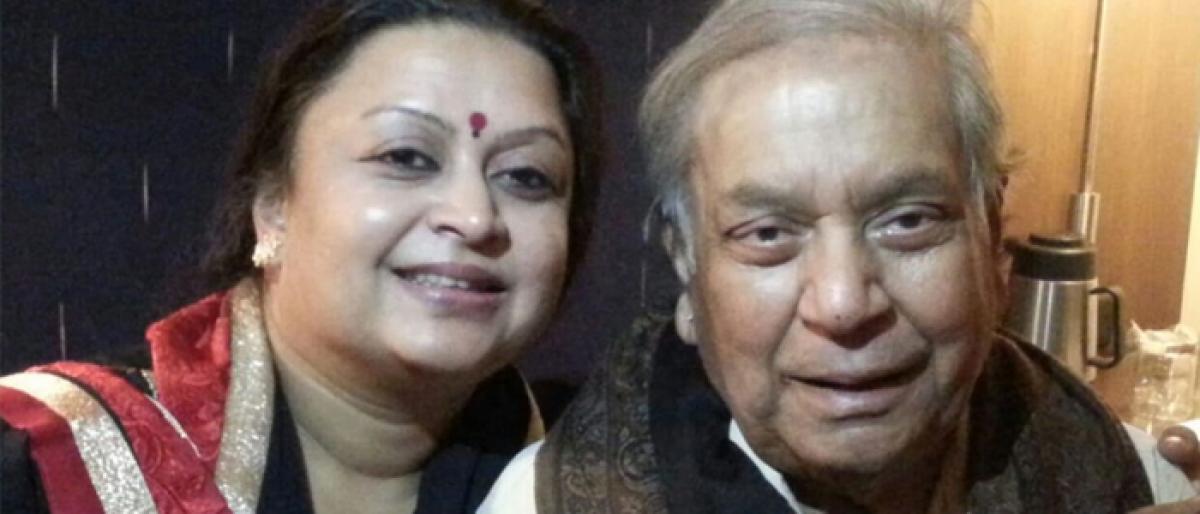Live
- ‘Oka Pathakam Prakaram’ trailer unveiled; raises curiosity
- Edge-of-the-seat thriller ‘100 Crores’ starts streaming on Aha
- Majhi flags off pilgrim bus services to Kumbh Mela
- From First Show to Blockbuster: Dakua Maharaj Takes the Audience by Storm
- Dil Rajuapologises for controversial remarks on Telangana culture
- Nikki Tambolisteals the spotlight with bold fashion choices
- MLA Danam Nagender’s Key Remarks Stir Controversy Again
- Overcome disability to achieve culinary success
- Minister Ponnam Prabhakar Assures Justice in Distribution of Indiramma Houses and Ration Cards
- AP sees rapid development under NDA govt., says Dy. CM Pawan Kalyan
Just In

Women in the family of Kathak legend Birju Maharaj did learn the dance form and performed within the household but never took it up professionally But his third daughter Mamtas persistence saw the guru relenting and the unsaid family norm being upended
Women in the family of Kathak legend Birju Maharaj did learn the dance form and performed within the household but never took it up professionally. But his third daughter Mamta's persistence saw the guru relenting and the unsaid family norm being upended.
The noted Kathak performer, whose lineage stretches seven generations, is among the first female professionals from the Lucknow gharana to adopt the dance form as a profession.
From when she was just five, Mamta watched performances on the sly and was exposed to many prominent dance forms -- primarily Kathak, but also Bharatanatyam, Kathakali and Odissi.
Having been trained by her father, the danseuse said her childhood at Delhi's Bharatiya Kala Kendra -- where her father used to teach -- was instrumental in developing her love for the form.
And, what began as a fun activity for Mamta, soon turned into something she couldn't separate herself from.
But, the going wasn't easy because women in Birju Maharaj's family could not take up Kathak professionally. "Women from our home never entered this field. Most of them did learn the basics, but never took it up professionally. Performances happened inside the domain of the household, but never publicly.
"I grew up surrounded by dancers, musicians, and singers. As children, my father allowed us to perform in Kathak recitals or ballet performances" but not once she grew up, Mamta told.
"My sisters accepted the norm of women not entering the professional dance realm, but I couldn't separate myself from this new passion that grew inside me," she explained.
"I decided that there is only going to be dance in my life; either that or the Army. Nothing else mattered at that point in my life."
She revealed that, after much convincing, the Kathak doyen finally gave in, paving the way for his daughter to become one of the female pioneers of the Lucknow gharana.
Mamta says she is the first female "ganda-bandh shagird" of her father, a huge honour for any disciple. "Ganda-bandhan" is an traditional ceremony between a guru and his select disciples, sealing their student-teacher relationship.
Does she see her father only as a guru?
"I have always seen him more as a guru than as a father. Even as children, we saw him in a disciplined environment," she said adding that she always faced the pressure of a bad performance denting her father's painstakingly built reputation.
Her elegant dance has now been around for more than 25 years, and is central to her life -- to the extent that marriage had to take a backseat.
An amused Mamta said her dance practice always occupied all of her being, and marriage could never mean what dance means to her.
"I attribute even my breathing to dance and music, because I share such a deep connection with it," she explained. She now teaches Kathak at the Delhi-based Kalashram, a training and cultural centre set up by her father, along with staging performances.
Her most recent performance was in the Karuna Rasa at the Kamani Auditorium, New Delhi, at "Navarasa 2018", a festival of classical dance and music organised by Ministry of Culture and Kalahetu. She performed alongside her niece Ragini Maharaj, who essayed the Shringara Rasa, with music by one of her two brothers, Jaikishan Maharaj.

© 2025 Hyderabad Media House Limited/The Hans India. All rights reserved. Powered by hocalwire.com







